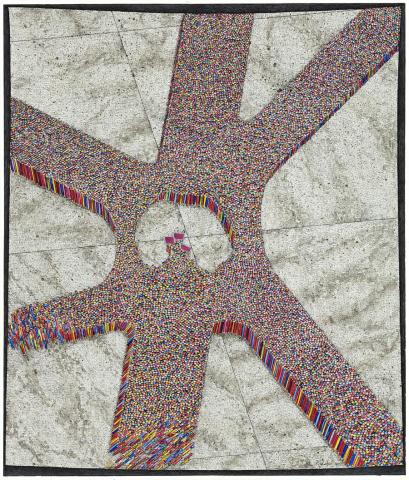MULTITUDE, 1985
JOHN BRACK
watercolour, pen and ink on paper
87.0 x 74.0 cm
signed and dated lower right: John Brack 1985
Private collection, Melbourne
John Brack, DC-Art, Sydney, September – October 1988
A Question of Balance: John Brack 1974–1994, Heide Museum of Modern Art, Melbourne, 1 April – 28 May 2000
Grishin, S., The Art of John Brack, Oxford University Press, Melbourne, 1990, vol. II, cat. p298, p. 73, p. 246 (illus.)
Gott, T., A Question of Balance: John Brack 1974–1994, Heide Museum of Modern Art, Melbourne, 2000, p. 21 (illus.)
Seeking a new visual metaphor that would permit him to explore the realms of human interaction specifically within the context of conflict, in 1978 Brack embarked upon his widely acclaimed 'pen and pencil' paintings (see lot 6) - a series which, occupying him for over a decade, ponder humanity's perpetual disputes over power and territory, as well as the persistence of violence in social relations. Thus, in these 'more mundane conflicts'1 as one critic dubbed them, the pens, pencils and other inanimate objects of his studio now become the active figures of his paintings - forming groups, declaring allegiances, breaking rank and marching in triumph. Although initially received with ambivalence and even disdain, today such compositions remain invariably celebrated for the complex myriad of meanings which they betray; as Robert Rooney exclaimed in their praise,'within the prescribed limits of their stylish precision and the massed accumulation of obsessively repeated forms, there is something more substantial than the restless demands of change. It is the triumphant victory of inspiration toward unity and order.'2
And certainly, the present watercolour is no exception. Examining the manner in which crowds so easily degenerate to primitive states, Multitude conjures up impressions of a huge thronging mass converging on a tiny pocket of space in the centre of which stands a barely discernible group of figures waving banners. No doubt inspired by the artist's own self-confessed aversion to crowds, the work is also a powerful declaration for the survival of individuality under threat. Yet as with the best of his achievements, there is none of the emotion which one might associate with such a theme - to the contrary, the treatment is completely impersonal and detached, thus ensuring the picture retains a silent, permanent universality.
As Helen Brack elaborates, 'We look down upon this tableau - placed over a black space of nothing - at the configuration made by a multitude of pencils standing on a grey tiled marble floor. The configuration is a multi-image of both a figure from primitive art and of a non-military triumphal march, with perhaps a reference to the Paris Arc de Triomphe. This configuration also suggests the raised arms of triumphant cheering. All the people are pencils - not a pen in sight, no force or coercion - however some pencils have shiny enamelled heads and some are bare headed, the wood and black lead visible. Is this multitude also multicultural? Is this multitude the family of Man? 'The multitude's surge is towards the centre where the three banners are, but this multitude goes way beyond the platform of the marble, yet is not part of the black nothing behind the tableau. The centre tableau space, both heart shaped and the head of the configured primitive figure, is also the centre of the vast cold gray marble ground on which this multitude stand. Marble, the past, the civilisation of classical Greece, our inheritance; the two configurations match but are out of alignment, the direction of the floor being clearly defined by the lines dividing the vast marble square tiles. The markings of these tiles - our past civilised achievements, our deaths - are concentric, perhaps a questioning of the limits of civilized being within our feral echo. The dark nothing behind the tableau, the universe outside our world, is a device John constantly used in his mature work.'
We are grateful to Helen Brack for her assistance with this catalogue essay.
1. Rooney, R., 'Pencils and pens draw battle lines on John Brack's canvases', The Weekend Australian, 28-29 September 1985
2. ibid.
VERONICA ANGELATOS
